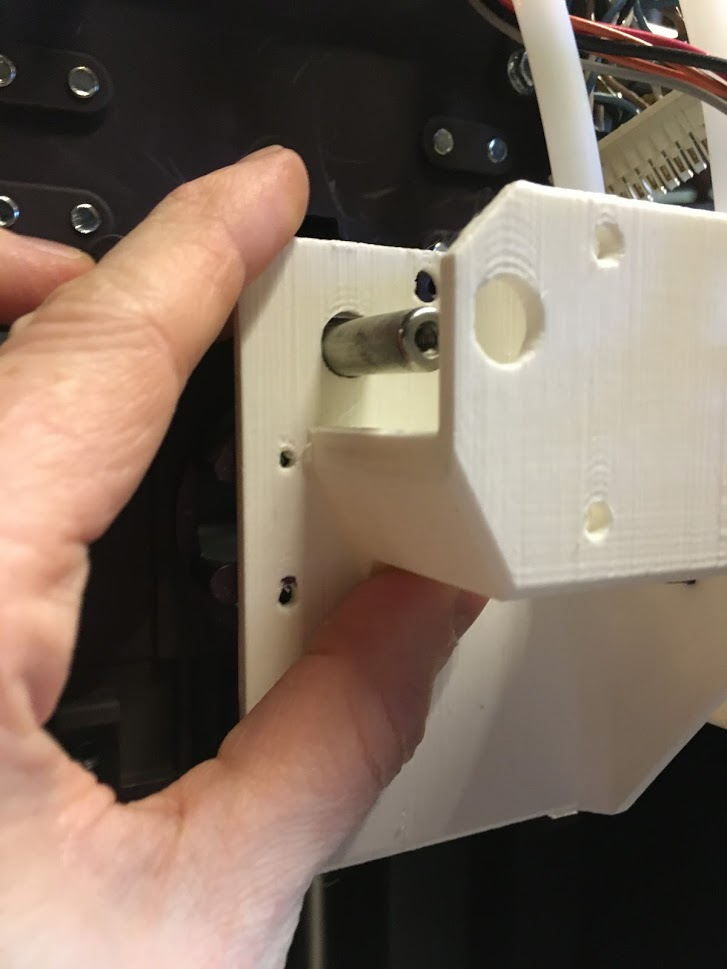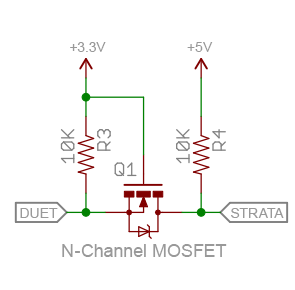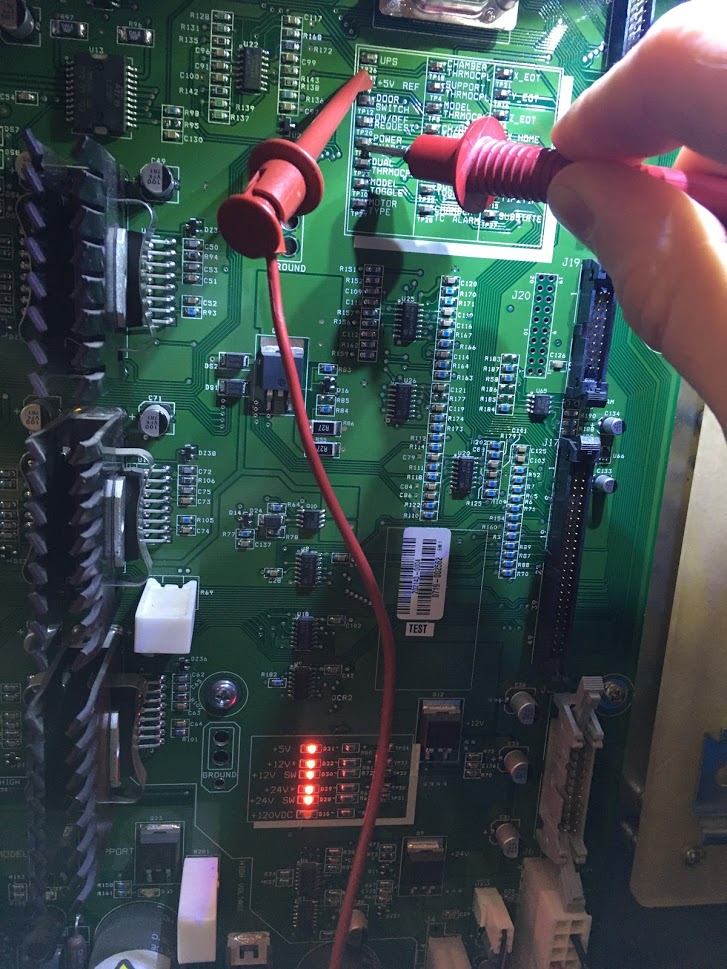Another Stratasys uPrint retrofit
-
This is my first attempt at a mounting solution for a bondtech bmg extruder. The pin in the middle really gets in the way.
The stock hotend has a number of drawbacks that limit its usefulness.- Not going to print PLA, or anything even the slightest bit flexible the way it's designed. That PC-ABS 430 has a very high glass transition tempature. The oem hotend (liquifier) isn't really meant for printing any low tempature materials.
- non metric nozzle size is going to make slicing interesting
- No or very little retraction. They call it a liquifier for a reason, pc-abs has some unique properties designed for this printhead.

-
@drphil3d said in Another Stratasys uPrint retrofit:
I traced the pins and found that J15 is the same as J17 on the 1200SST.
Great to hear! That's exactly what I was guessing since they both use the same controller board and on-board computer.
@drphil3d said in Another Stratasys uPrint retrofit:
I was able to enable the heated chamber and other accessories. Now I face another issue, how do I control it. I can't use the heated bed output on the duet sense that would feed 24v into a 5v pin...aaaahhh.
The easiest thing you could probably do is connect to a controlled fan output at 5V (this is possible right?). Or get a I/O 3.3v to 5.0v logic level shifter such as the TXS0108E and then connect to the EXT pins.
-
Yeah, that's exactly what I was thinking. Change the jumper to 5V on one of the fan outputs and connect that to the heated chamber, then figure out how to update the config to use the fan pin for chamber heater control.
Another option I was just thinking of, is I could breadboard a transistor and some resistors to signal the chamber heater using one of the 3.3v pins on the duet.
I would drive the heated chamber mosfet directly, however they used a mosfet that has a control voltage limit of 15v, otherwise I could just feed the heated bed output directly to the heated chamber test point pin (TP2).
-
@drphil3d said in Another Stratasys uPrint retrofit:
Another option I was just thinking of, is I could breadboard a transistor and some resistors to signal the chamber heater using one of the 3.3v pins on the duet.
Sure. That's basically one one direction logic level shifter. Here is an example:

-
@AJ-Quick sorry I have been away for a bit and received no notifications.
A bit pressed for time but I will come back and follow up in the next day or two. Short version; and I may be repeating myself but I haven't gone back to re-read.
Integration progresses slowly. I ended up driving the motion steppers directly from the Duet. On the uPrint, each stepper has a discrete connector into the electronics enclosure. So I just ran an umbillical direct to those connectors and bypassed the uPrint electronics entirely.
I used logic level shifters to fire the chamber heater and system power SSR's. Same for the extruder heaters. Same for endstop signals going back to the duet.
I tried a simple resistor voltage divider network for the thermocouple signals but that wasn't successful due to protective resistors on the uprint electronics. Then I realised at the 10 mV/ C signal level, any designed temperature was going to be within the duet ADC allowable levels so I scrapped the voltage divider and now have reliable cabinet temperature sensing. Extruder is being strange and I haven't quite figured out the slope / offset going on there or how I'm supposed to get that calibration in the linear analog mode of reprapfirmware.
I am now protecting the ADC inputs with a 3V3 zener across each input.
Started on the PicServo integration and ran into headaches trying to interface to the H-Bridge in the uprint. I am now waiting for parts to build a patch lead that will go between the applicable chassis loom / electronics enclosure that will let me pull out the servo power and encoder wiring direct to the picservo board. This way the modification is still entirely non invasive.
I actually had a call from the printer owner asking about lead time to return the printer to factory as they were being asked about printing face shields. Pity the build volume isn't big enough to actually run that print.
While I wait for parts I have gone back to a separate job of integrating a duet to an old Prusa clone. Had some issues where the duet smoked a borrowed PanelDUE and also failed it's WiFi module

-
@AJ-Quick said in Another Stratasys uPrint retrofit:
Pete,
Have you continued to make progress?
Yes

Would you be able to share what you have done to make the integration a success so far? For example how connections have been made between the Duet and the Stratasys boards? Have you managed to integrate the material bay in anyway?
Biggest problem I hit when trying to be drop-in replacement was the driving the steppers. The TMC drivers appear to be adequate to drive the stepper motors but they are too smart for their own good. If you try to drive the uPrint power amplifiers with the TMC drivers, the TMC's get confused since there isn't a real stepper on the output providing back EMF and all the other goodies that let the TMC driver do it's job. If you use the Duex outputs of step/direction then you are limited to whole steps I believe and then we waste the potential of such a rigid motion gantry. I ended up just running an umbilical out through the grommet on the LHS of the electronics cabinet. With each motor having its' own connector into the cabinet, this was simple and still non invasive.
For now I'm not touching the material bays. I'd like to come back to that problem at a later date since the load/unload mechanism is really nice.
I have been working on something very similar. The goal was to make it completely plug and play. Ethernet Duet in, while still completely maintaining the Stratasys motor controllers, thermocouplers, servo drive and dual extruders. Something that can be dropped into any uPrint and be operational in only 30 minutes or so.
Some questions I have:
How did you change from the Duet's Step / Direction signals into the PWM signal the Stratasys board requires? Did you bypass the Stratasys board to run the steppers from the Duet directly?
My understanding of the stepper power amplifier block is that it functions basically like one side of an H-Bridge but it provides current limiting for each winding. It still takes step/direction inputs. I have a link someplace where the question was asked and explained. It is an unusual implementation of the driver chip, but it does work. As mentioned above, it doesn't work with the TMC drivers on the Duet so I bypassed the whole lot.
The extruder is a DC servo motor, hence the PicServo. I haven't gotten very far with that because (again), I got wrapped around the axles trying to use the existing power amplifier hardware. I will be bypassing that also. Just waiting on the required connectors to test the prototype idea.
I am keeping all of the mechanical hardware completely original; Stratasys did a fantastic job and I don't want the headaches of trying to make a reliable hotend assy when the hardware in there is excellent.
If you want to share / work together I'd love to help get something off the ground here. I have lots of information, pinouts.. etc written down somewhere. If I ever got it working, I'd be doing open source and conversion kits. Now that I know more people are trying to achieve the same, I'd be happy to start compiling data and code to post on Github.
My intention has always been to make the BOM, wiring data and gerbers available. I have no desire to supply hardware kits; been there, done that, not interested. I have started pushing bits and pieces up to github but I'm still getting my head around that ( I'm a system integrator, not a software guy).
For expectation management, I'm doing this in slow time for my own enjoyment. I will eventually have something usable to release but I'm not setting any sort of deadline. Happy to collaborate if you are interested, flick me a PM and we'll take it offline.
-
@Pete_A said in Another Stratasys uPrint retrofit

My understanding of the stepper power amplifier block is that it functions basically like one side of an H-Bridge but it provides current limiting for each winding. It still takes step/direction inputs. I have a link someplace where the question was asked and explained. It is an unusual implementation of the driver chip, but it does work. As mentioned above, it doesn't work with the TMC drivers on the Duet so I bypassed the whole lot.
Yes! I was totally used to using drivers that controlled both sides of the H-Bridge simultaneously. To come across this weird DC motor controller being split into two phases really threw me through a loop. You are correct that you can essentially hook up a Step / Dir signal, but to be super effective it should be a PWM signal that can micorstep.
That person that asked the question was me! https://electronics.stackexchange.com/questions/398928/interfacing-with-two-full-bridge-pwm-motor-drivers-to-control-a-stepper-motor
Check out the page I started writing about the uPrint here: https://wiki.cnc.xyz/Stratasys_uPrint_Retrofit
It outlines how to operate the on-board steppers, servo and reading things like thermocouples. Unfortunately right now it's all just theoretical. I'm waiting for my new PCB adapter boards to arrive next week. I'm feeling pretty good about it though. In theory I will have every function controlled by the Duet (except for the Material Bay) by the end of next week.
-
I'm trying to post a useful reply but the stupid akismet spam filter keeps blocking me for some reason

Small world :). The provided explanation was really helpful. When I first saw the circuit diagram and design constraints I just knew it was for a uPrint.
Pins arrived today for my extruder splice loom. No connectors though

Had a quick look through the wiki page; nice and concise. Would have saved me a bunch of work

-
@Pete_A said in Another Stratasys uPrint retrofit:
stupid akismet spam filter keeps blocking me
usually works if trying again a little later
-
@drphil3d said in Another Stratasys uPrint retrofit:

One thing I should make sure you know. Do not use the +5V ref to supply 5 volts anywhere. That is a steady voltage reference for the thermocouples. It is not capable of supplying very much more than a few mA. Use the +5V testpoint instead (lower down on this photo).
-
-
@aj-quick there is a fork of paneldue with landscape display and support for a knob encoder by diabase. You could look at that.
-
@drphil3d i have a 768 sst and am interested in what you have going here do you think a full rebuild would not be best?
-
@rexx said in Another Stratasys uPrint retrofit:
768 sst
I would say try to keep as much of it together as possible. I have been working with a more recent duet 2 wifi + Duex5 and the latest RRF 3 to take control of a Uprint SE+. The newer duets allow 5V in on the endstop inputs. The Duex5 allows for 5V logic to control the different switches and SSR on the PDB. I have gained control of everything even the dc servo motor using a Geckodrive G320x. I imagine with the 768 sst you would just need 2 G320x external drivers. I interfaced it with the CONN_LCD step dir outputs. Since there are two there, you shouldn't run into any issues. I have the Duex5 for the PWM outputs for controlling the heaters, power enable, and some logic signaling and thermistor inputs for directly reading the thermcouple 10 mv/C output from the J13 or J15 connector. To calibrate the temperature range you will need to use a voltage divider to take the 5V signal scaled down to 3.3V. Auto PID tuning worked great. I have even been able to gain control of the material bay with some soldering of wires. Still working on configuring the right pinouts to control the material bay. I'm having an issue with the fan outputs as GPIOs. I may have to find other pins, yet am quickly running out of enough pins to control everything. 5V and Vin both read in on the fans, yet the PWM pins max out at 0.5 V. I can set it to 0 and get 0V, yet it won't give me the full 5V or 24V Vin output. Not sure if I am already pulling too much from the 5V regulator or if I may have accidentally blown all of the fan mosfets. Not sure when that would have happened. I am still working on getting things calibrated and all the safety outputs run into the duet, yet once I do I'll be sure to post the whole setup here on the forum.
-
@archeantus Very interested to see what you have accomplished!
-
@aj-quick I am entering what I have done with the help of the wiring diagrams you posted on your website to the Hackaday.io Hack It Back competition.
Feel free to see what I have been doing and videos of the functioning Uprint SE+ fully controlled by the Duet 2 WIFI with DueX5 expansion board and Geckodrive G320X servo motor controller.
The link is here: https://hackaday.io/project/186419
I will be uploading the Duet configuration files and macros plus more information on the wiring in the coming days. I still have some more work to do to get it to run flawlessly, yet both extruders work and the chamber heater works with reasonable PID profiles.
I have printed ABS and PLA, yet haven't figured out the best chamber temps for the PLA to cool properly. Right now I can use either the Stratasys ABS in the spool under the printer or my Hatchbox ABS from a spool behind the printer. Both print wonderfully. The video is using the Hatchbox PLA red filament.
I will likely be adding an air filter to help with the ABS fumes as well as a PanelDue 5i for convenience when using the printer.
Please let me know what you think!
-
@archeantus Absolutely impressive!
I would like to know how you have controlled the stepper motors directly from the Duet though the PDB. As I remember it, the onboard drivers take a PWM sine signal for control instead of regular step signals. Did you work out another way to do it using the Duet drivers directly!?
-
@aj-quick I run the motors directly from the Duet.
Hey, I wouldn't have been able to get where I did without your work. Would you like to be added as a contributor to the project?
-
@archeantus the extruder is controlled from the step and dir pins sent to the Geckodrive G320X. I feed the output from the Geckodrive through the PDB. During the tool change I switch the motor driver direction to make it always extruder the right way depending on which tool is being used.
-
@archeantus said in Another Stratasys uPrint retrofit:
Hey, I wouldn't have been able to get where I did without your work. Would you like to be added as a contributor to the project?
I've got a Hackaday account now, not sure what that entails: https://hackaday.io/ajquick
@archeantus said in Another Stratasys uPrint retrofit:
@aj-quick I run the motors directly from the Duet.
Would you be able to explain more? Mainly just what connections on the Duet are made to the PDB for the motor control? From the drivers directly? Any bypassing of the drivers on the PDB already?